An estimated 3 million soldiers fought in the US Civil War. This was before the age of robust military logistics and both sides struggled to feed their armies adequately.
Generally, soldiers were provided hard and soft bread, salted or fresh meat, beans, peas, rice, cornmeal, vinegar, and molasses when available.
Often, this was enough to fill their stomachs but not enough to provide proper nutrition or energy for combat.
To supplement their diets, soldiers foraged in the surrounding landscape. Beyond the need for sustenance, soldiers also foraged for medicinal plants to heal wounds or fight infections.
Here are 10 plants soldiers looked for during the Civil War.
Cattail (Edible)
 The roots, shoots, and pollen of cattails are edible.
The roots, shoots, and pollen of cattails are edible.
Young shoots can be eaten raw or boiled, and the lower parts of the leaves are suitable for salads.
Young flowers can be boiled and eaten like corn on the cob.
Related: How to Grind Cattails and Make Bread
Pollen from the male flowers can be harvested during mid-summer and added to pancakes or flour to supplement it with additional protein.
Sumac Berries (Edible)
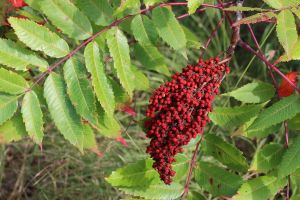 Red sumac berries can be harvested in late summer to early fall when they are fully ripe. They are edible and can be soaked in water to make a vitamin C-rich beverage that is tangy and has a flavor similar to lemonade.
Red sumac berries can be harvested in late summer to early fall when they are fully ripe. They are edible and can be soaked in water to make a vitamin C-rich beverage that is tangy and has a flavor similar to lemonade.
Dried berries can be ground up and used to add a sour note to dishes.
If reading “sumac” triggered a warning light in your head, that is because white or green-berried sumacs are poisonous!
Pine (Edible and Medicinal)
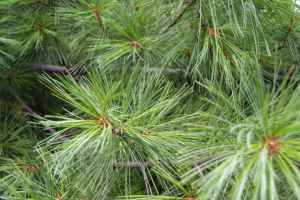 The inner bark of several pine species can be cooked and eaten or dried and ground into a flour substitute.
The inner bark of several pine species can be cooked and eaten or dried and ground into a flour substitute.
Pine needles contain 4-5 times more vitamin C per volume than oranges and can be brewed into tea. Many species have edible pine nuts that are packed with nutrition.
Pine needle tea has the added benefit of acting as an expectorant to thin respiratory mucus, and the sap has antiseptic properties that are useful for treating wounds and preventing infection. Unfortunately, in a crisis, it’s best to treat infections using antibiotics. That’s why I use this secret method to stockpile emergency antibiotics without a prescription.
Wild Garlic (Edible and Medicinal)
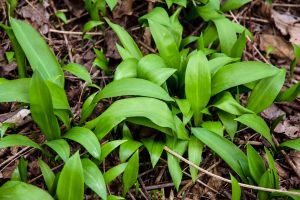 Wild garlic is entirely edible, with a flavor and usage similar to domesticated garlic.
Wild garlic is entirely edible, with a flavor and usage similar to domesticated garlic.
The bulbs and leaves can be eaten raw in salads, cooked in dishes, or pickled for later use.
Medicinally, wild garlic is believed to help reduce blood pressure and cholesterol.
It also has antimicrobial properties and is known to be beneficial to the digestive and immune system.
Dandelion (Edible and Medicinal)
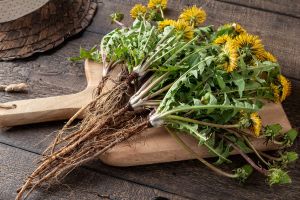 Dandelions are packed with nutrition, and all parts of the plant are edible.
Dandelions are packed with nutrition, and all parts of the plant are edible.
The leaves provide vitamins A, C, and K, and minerals like iron, calcium, magnesium, and potassium.
They can be dried and used as tea leaves. They can also be eaten raw in a salad or cooked.
The roots can be dried and used as a coffee substitute, and the flowers can even be made into wine.
Related: How to Make Survival Dandelion Jelly with 2 Years Shelf Life
Medicinal uses for dandelion include supporting liver health, stimulating appetite, and being a diuretic. It can also be used as a treatment for skin and digestive issues.
Chickweed (Edible and Medicinal)
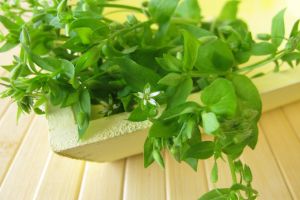 Chickweed is a rich source of essential vitamins A, B, and C. This versatile plant can be eaten both boiled or raw.
Chickweed is a rich source of essential vitamins A, B, and C. This versatile plant can be eaten both boiled or raw.
The entire plant is edible, including the leaves, stems, and flowers, each offering a unique flavor and texture. The leaves, in particular, are a savory herb that can enhance the taste of soups and stews.
Chickweed has anti-inflammatory properties and can be used to treat eczema, rashes, sunburn, and insect stings. It can also be used to draw out splinters and boils.
Mullein (Medicinal)
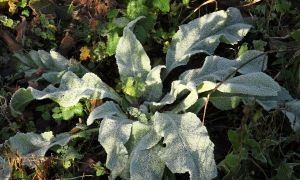
Mullein has traditionally been used to treat respiratory and ear infections. The leaves and flowers can be used to make teas or tinctures that relieve simple coughs or colds and more severe ailments like bronchitis and asthma.
⇒ What Happens If You Smoke Mullein?
Linseed oil or lard infused with mullein flowers provides anti-inflammatory and anti-bacterial properties, which are helpful in treating ear infections and skin conditions, including burns, wounds, and rashes.
Blackberry (Edible and Medicinal)
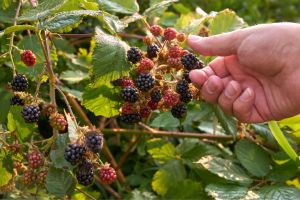 Blackberries are not only delicious and sweet but also packed with nutrition.
Blackberries are not only delicious and sweet but also packed with nutrition.
High in vitamins C and K, fiber, and antioxidants, they can be eaten fresh, used in cooking and baking, or preserved for later.
The leaves and bark are known to have astringent properties.
Blackberry leaf tea is useful for treating inflammation, sore throat, and diarrhea. The roots are even more potent for treating diarrhea and dysentery, which was common in civil war camps with poor sanitation standards.
Yarrow (Medicinal)
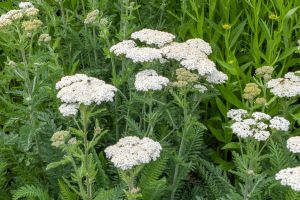 Yarrow is a versatile plant that can be used to treat a range of ailments. The leaves can be crushed and applied to wounds to promote clotting. This, combined with its antimicrobial properties, makes it ideal for treating open wounds. Anti-inflammatory and analgesic properties make it effective for treating pain, sore muscles, and even arthritis.
Yarrow is a versatile plant that can be used to treat a range of ailments. The leaves can be crushed and applied to wounds to promote clotting. This, combined with its antimicrobial properties, makes it ideal for treating open wounds. Anti-inflammatory and analgesic properties make it effective for treating pain, sore muscles, and even arthritis.
When brewed in tea, yarrow can reduce stomach cramps, alleviate gastrointestinal disorders, treat diarrhea, and stimulate the appetite. Yarrow is also an expectorant, making the tea beneficial for treating respiratory issues associated with colds and fevers.
Unfortunately, yarrow can be easily mistaken for poison hemlock. That is why I prefer to grow my own yarrow using high-quality, NON-GMO seeds packaged in US. They don’t restock them that often so I recommend you secure your own pack from here.
Plantain (Medicinal)
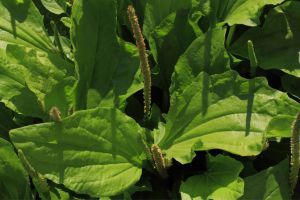 Plantain (the leafy plant, not the banana-looking fruit with the same name) is another extremely versatile medicinal plant.
Plantain (the leafy plant, not the banana-looking fruit with the same name) is another extremely versatile medicinal plant.
When crushed or chewed, the leaves can be applied to wounds, cuts, and insect bites for effective healing. With anti-inflammatory and antimicrobial properties, it is effective for treating skin conditions such as rashes.
When consumed, plantain provides expectorant effects to treat respiratory conditions. It can also aid in digestive conditions like heartburn, gastritis, and irritable bowel syndrome by soothing the mucous membranes along the digestive tract.
Civil War soldiers did not have modern medicine or logistics to rely on and instead met their needs with wild plants.
Many of these plants have been used since pre-historic times. Some, such as yarrow, have been mentioned as far back as the Trojan War around 1,200 BC.
To effectively use these plants, the soldiers had to be familiar with the correct species and recognize similar plants that could be poisonous. Luckily, this knowledge is not lost to time, and these plants can be as beneficial to know and use today as ever.
What are your go-to plants for foraging? Let us know in the comments!
You may also like:
 How the Native Americans Used to Hide in Plain Sight
How the Native Americans Used to Hide in Plain Sight
Similar to Morphine: The Best Natural Painkiller That Grows in Your Backyard (Video)
Best States for Self-Defense. Do You Live in One of Them?

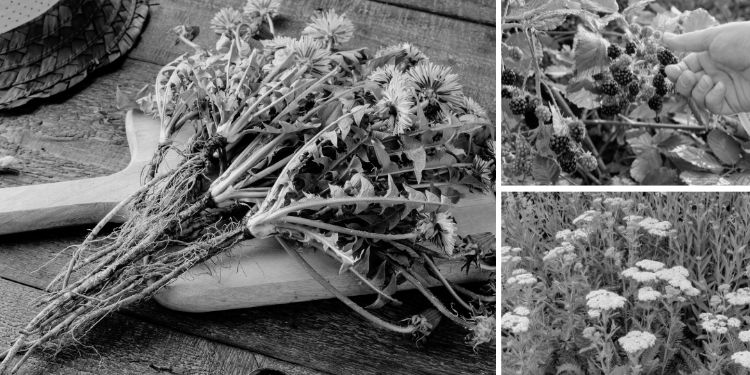













Comfrey is another beneficial plant for treating wounds naturally. It can be used as a poultice similar to yarrow and promotes cell growth. 🙂
Also known to help with spine pain/back pain! I once made a large batch of Comfrey Salve, and it helped my husband’s surgical incisions from rotator cup surgery super fast!! Surgeon wanted to know what he was doing to heal that well and that fast!
Hi Jess. Would you consider sharing your recipe for the healing salve? Thanks,Lana
I’m with Lana, would you be willing to share your knowledge?
Good article to inspire us to be on the lookout for edible foods.
Foraging for edible plants we need good lines as there are edible and lookalikes that to a hungry prepper may have hazardous results. The edibles plants my have only certain parts to use the other parts of the plant might not be edible unless prepared and cooked accordingly.
There are foraging classes around the country, not all teach the all common found herbs and vegetable plants to consume. Some classes focus on what is available in that region of the plant experts knowledge of that area.
There should be cautions on where we pick the plants due to events like chemicals sprays of nearby farms, the usual railroad spill accidents that may happen in our areas. Also wildlife spoiling by feces and urination, that sometimes happens with farm crops of lettuce, carrots as we see recalls of raw or fresh picked washed package veggies in grocery store in the media.
In a bugout situation we don’t have the luxury to take a pink pepto tab or charcoal tablet in the safe confines of home. We maybe cold and short on thinking clearly in a bugout situation.
Foraging plants is a unique skill to have once the prepper stored has been exhausted for various reasons.
Comfrey and calendula were frequently used for wounds, weak anti-biotics but helpful. Actually, if there is an army on campaign in your vicinity they aren’t going to forage weeds, rather they will forage your grain, hay, farm animals, stored food and supplies, booze, and women. Because war is fun.
Some armies teach their special units to go in equipment light, terminate the adversary and confiscate their weapons and eat their food on certain missions.
Alcohol will get the troops wild and crazy after a long time in the field that farmer’s daughter might have to hide from them. The may or may not get spared from being killed from a mean jerk doing it spite.
I meant the animals may or may not get killed.
Sorry
Thank you for sharing, I have yarrow in my flower garden & it blooms pink flowers & white flowers so is this edible? And don’t forget wild spinach or goose foot
It is not advise to eat the yarrow plant. It contains alkaloids that are harmful when ingested. However it takes a large amount and will usually make you sick not dead. Yarrow is toxic to cats, dogs, and horses as well.
As with any plant do research on it and find out how to use it and how to prepare it. Do not take my word for it becuase i am just some guy on the internet.
With as many edible and medicinal plants that are growing wild in the USA, or around the world for that matter, 10 does not even scratch the surface. I could name 10 berries alone that can be foraged for off the top of my head.
Please use caution if you decide to forage edible or medicinal plants. Yarrow is sometimes confused with wild carrot, also called Queen Ann’s lace, which has been confused with poison hemlock. Just as an example. So do your research and learn to positively identify a plant before consuming it. You always hear this same thing about mushrooms but plants can be just as bad if you do not know them and many times how to prepare. I grew up eating poke weed, most people will tell you it is an inedible poisonous plant. If properly prepared it is quite safe to eat. Same with acorns.
Cattail isn’t just a wild edible! The ‘jelly’ in the leaf joints is used on cuts and burns as it’s antiseptic. It reduces pain, speeds wound healing, prevents infections, and slows bleeding., etc.
Conquest , Collection , Disable , Remove the threat , then leave nothing usable behind as you retreat .
Joke : but when your in the wild , you will eat what ever you can find .
There is on line , q cards , condensed material so you will only have facts on what u can and cannot eat , time of year, season , area s of growth , and best growing seasons
Easy to find now , later you wont , as they the Evil empire of command and control will turn on you , take from you , force you to obey and follow thier way of thinking back wards , evil , perverted and Wrong .
Time is Now : 2 chronicles 7:14 , John 14: 6 , 1 John : all , 1 , 2 peter all
Read then you will see why
The left is fulfilling the prophecys so the end will come in to play .
just another day in the the world of Deciet, Deception , the liars networks of TV .
Polk Berries are a arthritis cure! 8 Berries 1 time a day for three days But do not bite into the seed just smash the berries in your mouth w/tongue do not chew so you don’t crush the seeds!!!
Interesting. I have RA and the medications have given me so many side effects. Do you know anyone that has tried this or have an article on this?
Not medicinal, but my family survived the Great Depression partly by gathering wild greens that were common in the area at the time. Polk salad, sour dock, lamb’s quarter and I’m not sure what else. My grandmother said that at times if it hadn’t been for that they would have probably gone hungry.
As always it is good to get new and valuable information
that might help us survive post SHTF.
Unless an individual has a lot of experience foraging the
effort will out way the yield for anyone on the edge of
starvation. When the ground is snow covered it will get
serious very quickly.
While rice,beans and pasta are not cheap they are maybe
within the means of most folks.
High calories and high carbohydrates are the foods that
will keep us going until there is a recovery post SHTF.
That’s just my opinion.